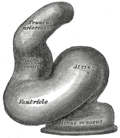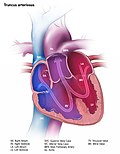Truncus arteriosus
A rare congenital heart defect
Truncus arteriosus is a rare type of congenital heart defect in which a single blood vessel (the truncus arteriosus) comes out of the right and left ventricles, instead of the normal two vessels (the pulmonary artery and the aorta). This condition results in a mixture of oxygenated and deoxygenated blood being circulated throughout the body.
Anatomy and Pathophysiology[edit]
In a normal heart, the pulmonary artery and the aorta are separate, with the pulmonary artery carrying deoxygenated blood from the right ventricle to the lungs, and the aorta carrying oxygenated blood from the left ventricle to the rest of the body. In truncus arteriosus, these two vessels are combined into a single vessel, which then branches into the pulmonary arteries and the aorta.

The condition is often associated with a ventricular septal defect (VSD), which is a hole between the right and left ventricles. This allows blood to mix between the two sides of the heart, leading to reduced oxygen levels in the blood that is pumped to the body.
Types[edit]
Truncus arteriosus is classified into several types based on the anatomy of the pulmonary arteries and their origin from the truncus. The most commonly used classification is the Collett and Edwards classification, which includes:
- Type I: A single pulmonary trunk arises from the truncus arteriosus and then divides into the left and right pulmonary arteries.
- Type II: The left and right pulmonary arteries arise separately but close to each other from the posterior aspect of the truncus.
- Type III: The left and right pulmonary arteries arise separately from the lateral aspects of the truncus.
Diagnosis[edit]
Diagnosis of truncus arteriosus is typically made using echocardiography, which can visualize the single arterial trunk and associated VSD. Other imaging techniques, such as cardiac MRI or CT scan, may be used to provide additional anatomical details.

Treatment[edit]
The treatment for truncus arteriosus is surgical. The goal of surgery is to separate the pulmonary and systemic circulations. This is usually done by closing the VSD and creating a conduit from the right ventricle to the pulmonary arteries. Early surgical intervention is critical to prevent complications such as pulmonary hypertension.
Prognosis[edit]
With advances in surgical techniques, the prognosis for individuals with truncus arteriosus has improved significantly. However, long-term follow-up is necessary to monitor for potential complications, such as conduit obstruction or valve dysfunction.
Related pages[edit]
References[edit]
- Hoffman, J.I.E., & Kaplan, S. (2002). The incidence of congenital heart disease. Journal of the American College of Cardiology, 39(12), 1890-1900.
- Van Praagh, R. (2009). The segmental approach to diagnosis in congenital heart disease. Pediatric Cardiology, 30(5), 701-705.


-
Diagram of the heart showing truncus arteriosus
-
Illustration of the heart with truncus arteriosus
-
Heart anatomy with truncus arteriosus
-
Truncus arteriosus
Ad. Transform your life with W8MD's Budget GLP-1 injections from $75


W8MD offers a medical weight loss program to lose weight in Philadelphia. Our physician-supervised medical weight loss provides:
- Weight loss injections in NYC (generic and brand names):
- Zepbound / Mounjaro, Wegovy / Ozempic, Saxenda
- Most insurances accepted or discounted self-pay rates. We will obtain insurance prior authorizations if needed.
- Generic GLP1 weight loss injections from $75 for the starting dose.
- Also offer prescription weight loss medications including Phentermine, Qsymia, Diethylpropion, Contrave etc.
NYC weight loss doctor appointmentsNYC weight loss doctor appointments
Start your NYC weight loss journey today at our NYC medical weight loss and Philadelphia medical weight loss clinics.
- Call 718-946-5500 to lose weight in NYC or for medical weight loss in Philadelphia 215-676-2334.
- Tags:NYC medical weight loss, Philadelphia lose weight Zepbound NYC, Budget GLP1 weight loss injections, Wegovy Philadelphia, Wegovy NYC, Philadelphia medical weight loss, Brookly weight loss and Wegovy NYC
|
WikiMD's Wellness Encyclopedia |
| Let Food Be Thy Medicine Medicine Thy Food - Hippocrates |
Medical Disclaimer: WikiMD is not a substitute for professional medical advice. The information on WikiMD is provided as an information resource only, may be incorrect, outdated or misleading, and is not to be used or relied on for any diagnostic or treatment purposes. Please consult your health care provider before making any healthcare decisions or for guidance about a specific medical condition. WikiMD expressly disclaims responsibility, and shall have no liability, for any damages, loss, injury, or liability whatsoever suffered as a result of your reliance on the information contained in this site. By visiting this site you agree to the foregoing terms and conditions, which may from time to time be changed or supplemented by WikiMD. If you do not agree to the foregoing terms and conditions, you should not enter or use this site. See full disclaimer.
Credits:Most images are courtesy of Wikimedia commons, and templates, categories Wikipedia, licensed under CC BY SA or similar.
Translate this page: - East Asian
中文,
日本,
한국어,
South Asian
हिन्दी,
தமிழ்,
తెలుగు,
Urdu,
ಕನ್ನಡ,
Southeast Asian
Indonesian,
Vietnamese,
Thai,
မြန်မာဘာသာ,
বাংলা
European
español,
Deutsch,
français,
Greek,
português do Brasil,
polski,
română,
русский,
Nederlands,
norsk,
svenska,
suomi,
Italian
Middle Eastern & African
عربى,
Turkish,
Persian,
Hebrew,
Afrikaans,
isiZulu,
Kiswahili,
Other
Bulgarian,
Hungarian,
Czech,
Swedish,
മലയാളം,
मराठी,
ਪੰਜਾਬੀ,
ગુજરાતી,
Portuguese,
Ukrainian



